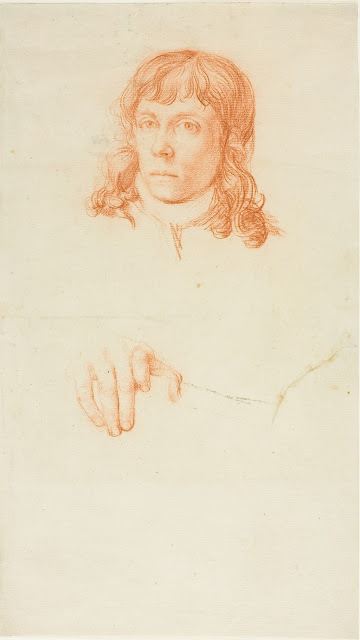 |
| George Romney Emma Hart (later Lady Hamilton) as Miranda 1785-86 oil on canvas Abbot Hall Art Gallery, Kendal, Cumbria |
 |
| Nicolas de Largillière Portrait of Charles-Léonor Aubry, Marquis de Castelnau 1701 oil on canvas Minneapolis Institute of Art |
 |
| Nicolas de Largillière Self Portrait ca. 1725 oil on canvas Art Institute of Chicago |
 |
| Rosalba Carriera Young Girl holding a Monkey ca. 1721 pastel Musée du Louvre |
 |
| Hyacinthe Rigaud Portrait of Antoine Pâris 1724 oil on canvas Norton Simon Museum, Pasadena |
A Hundred Bolts of Satin
All you
have to lose
is one
connection
and the mind
uncouples
all the way back.
It seems
to have been
a train.
There seems
to have been
a track.
The things
that you
unpack
from the
abandoned cars
cannot sustain
life: a crate of
tractor axles,
for example,
a dozen dozen
clasp knives,
a hundred
bolts of satin –
perhaps you
specialized
more than
you imagined.
– Kay Ryan (2000)
 |
| Hyacinthe Rigaud Portrait of Graf Philipp Ludwig Wenzel-Sinzendorf 1729 oil on canvas Kunsthistorisches Museum, Vienna |
 |
| John Singleton Copley Portrait of Mrs Henry Hill (Anna Barrett) ca. 1765-70 pastel on paper, mounted on linen Art Institute of Chicago |
 |
| John Singleton Copley Portrait of Daniel Hubbard 1764 oil on canvas Art Institute of Chicago |
 |
| John Singleton Copley Portrait of Mrs Daniel Hubbard (Mary Greene) ca. 1764 oil on canvas Art Institute of Chicago |
 |
| Sèvres Manufactory Bust of Louis, Dauphin of France 1766 porcelain Art Institute of Chicago |
 |
| John Flaxman Self Portrait ca. 1779 drawing Art Institute of Chicago |
 |
| Jacques-André Portail Portrait of François Boucher before 1759 drawing Art Institute of Chicago |
 |
| Jean-Antoine Watteau The Dreamer (La Rêveuse) ca. 1712-14 oil on panel Art Institute of Chicago |
 |
| Pietro Antonio Rotari Young Woman weeping over a Letter 1707 oil on canvas Alte Pinakothek, Munich |
from A Pillow Book
A Great Book can be read again and again, inexhaustibly, with great benefits to great minds, wrote Mortimer Adler, co-founder of the Great Books Foundation and the Great Books of the Western World program at the university where my husband will be going up for tenure next fall, and where I sometimes teach as well, albeit in a lesser, "non-ladder" position. Not only must a Great Book still matter today, Adler insisted, it must touch upon at least twenty-five of the one hundred and two Great Ideas that have occupied Great Minds for the last twenty-five centuries. Ranging from Angel to World, a comprehensive list of these concepts can be found in Adler's two-volume Syntopicon: an Index to the Great Ideas, which was published with Great Fanfare, but not Great Financial Success, by Encyclopedia Britannica in 1952. Although the index includes many Great Ideas, including Art, Beauty, Change, Desire, Eternity, Family, Fate, Happiness, History, Pain, Sin, Slavery, Soul, Space, Time, and Truth, it does not, alas, include an entry on Pillows, which often strike me, as I sink into mine at the end of a long day of anything, these days, as at the very least worthy of note. Among the five hundred and eleven Great Books on Adler's list, updated in 1990 to appease his quibbling critics, moreover, only four, I can't help counting, were written by women – Virginia, Willa, Jane, and George – none of whom, as far as I can discover, were anyone's mother.
– Suzanne Buffam (2016)